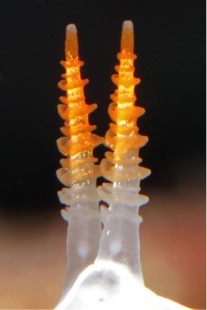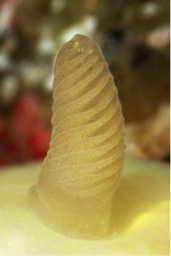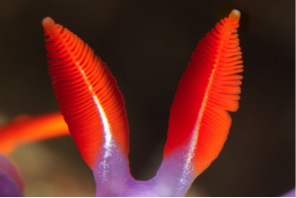What are sea slugs? Well, they are slugs that inhabit the ocean. Like land slugs, they are covered in slime and they crawl around on their foot. They leave slime trails, just like land slugs do. It was pointed out to me that the slime trails left by land slugs can act as a prism when hit by sunlight. This causes their trails to emit a beautiful spectrum of color.
Sea slugs unlike land slugs have adapted to the ocean in a variety of ways. Nudibranchs, a group of sea slugs, are known for their bright colors and ostentatious ornamentation. Their bright colors and diversity in shapes and forms have a purpose. What makes them so attractive and oftentimes strange is their frilly rhinophores and gills. What are rhinophores? They are horn-like structures which protrude from the front of the sea slug. “Rhino” means nose and “phore” means carrier. They are given this name since they give the sea slug their sense of smell. Our noses are capable of picking up chemical signals from the air. Rhinophores are able to pick up chemical signals in the water.
These rhinophores come in a variety of shapes, colors, and sizes. They have been organized into categories based on their shape. Some of these categories are smooth, rolled, sail-like, branched, so on and so forth. Many rhinophores are very elaborate. These more advanced and intricate rhinophores increase the surface area of the organ, which enhances detection of chemicals in the water.
Rhinophores are very important for the survival of most sea slugs, however, there are some sea slugs, which lack them. These slugs have other structures, which aid in their sense of smell. Rhinophores allow sea slugs to find their food and other slugs to mate with, avoid predators, and even sense changes in water pressure and vibrations. Different nerves within the rhinophores send information to the brain. Dendritic nerve cells pickup chemicals and ciliated nerve cells aid in sensing vibrations or changes in water pressure.
Finally, rhinophores help us classify and identify species of sea slugs. Below are some gorgeous Macro images of some rhinophores from California nudibranchs taken by marine biologist Gary McDonald. Enjoy!

Annulate rhinophores of the sea slug Flabellina trilineata

Lamellate rhinophore of the sea slug Cadlina modesta

Smooth rhinophore of the sea slug Doto amyra

Perfoliate rhinophores of the sea slug Flabellina iodinea
Carissa Shipman
Gradute Student
Department of Invertebrate Zoology and Geology